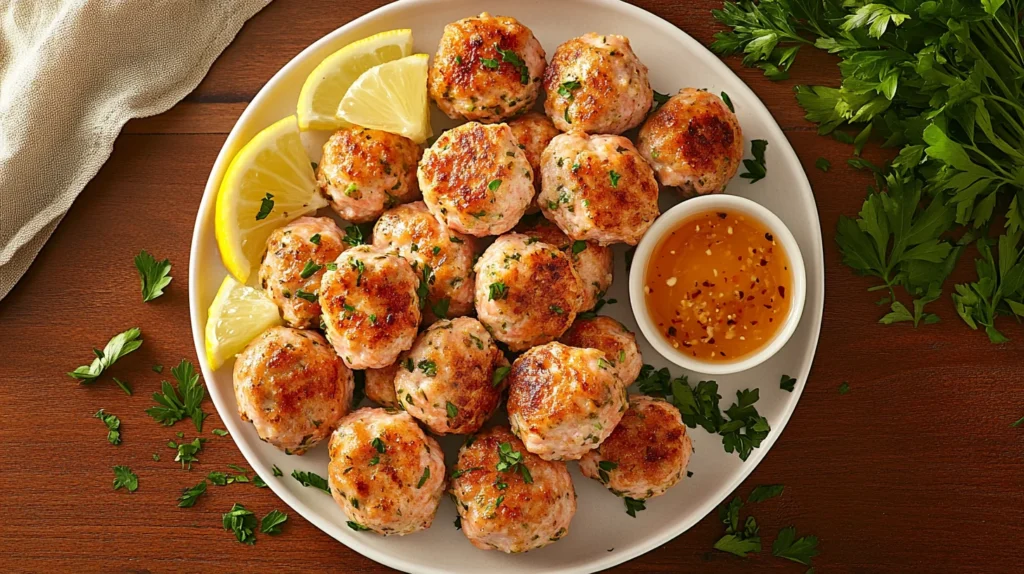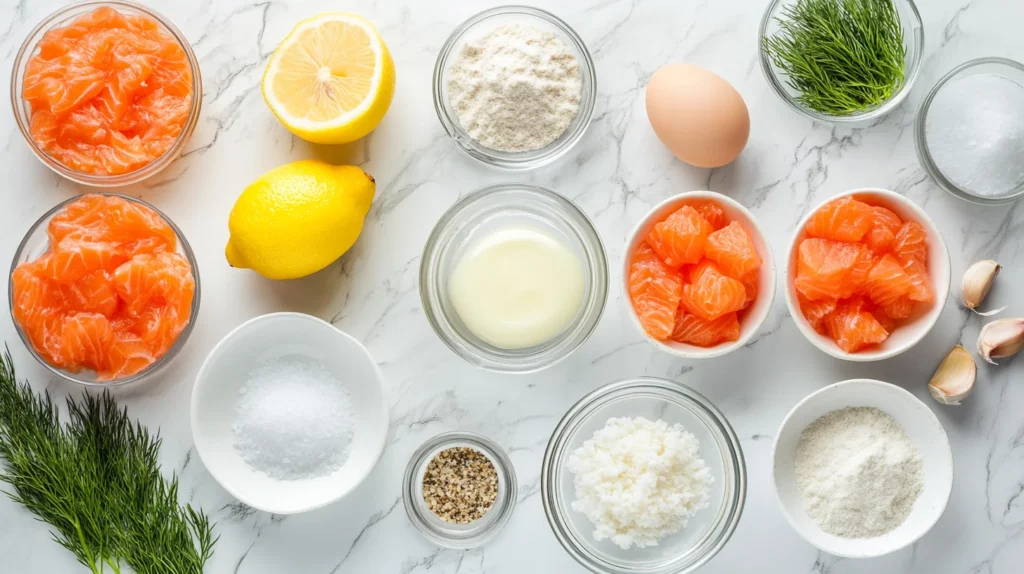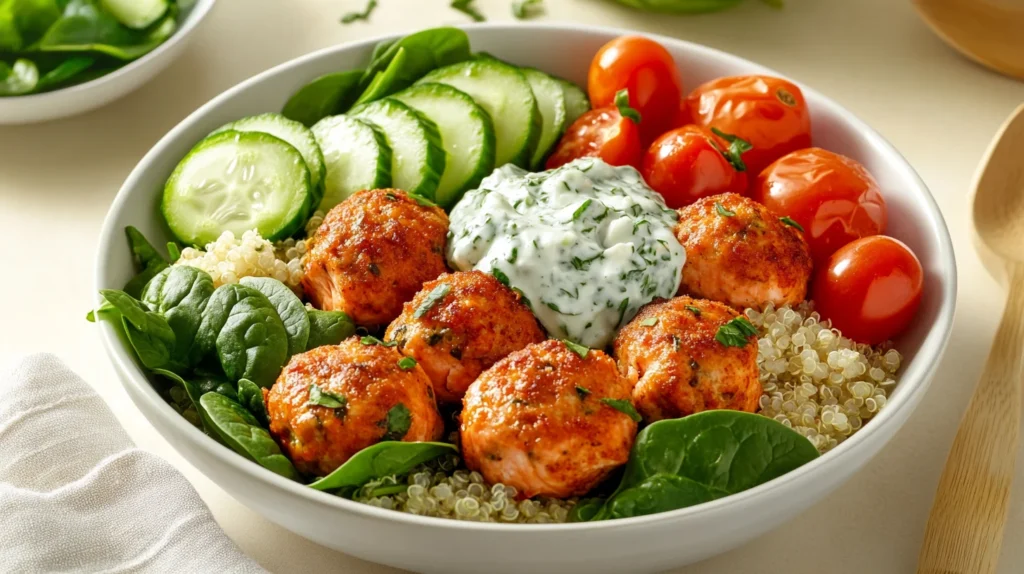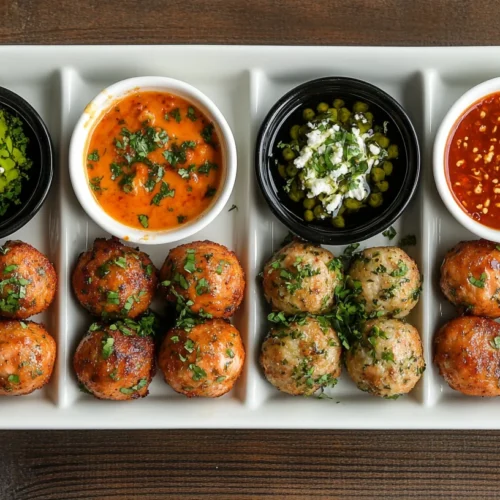Looking for a healthy twist on a classic favorite? Baked Salmon Meatballs might just be your new go-to. These flavorful, oven-baked bites combine the richness of omega-3-packed salmon with fresh herbs and simple ingredients for a meal that’s both nutritious and delicious.
Light, heart-healthy, and full of taste, they offer a great alternative to traditional meatballs—perfect for weeknight dinners, high-protein snacks, or elegant starters. Whether you’re trying to eat more seafood or just shake up your usual routine, these salmon meatballs are easy to make, quick to clean up, and endlessly customizable.
In this article, we’ll cover everything from health perks and step-by-step instructions to smart tips, tasty variations, and creative ways to serve them. Let’s get started and bring these savory salmon bites to life—straight from your oven!

Health Benefits of Baked Salmon Meatballs
Choosing Baked Salmon Meatballs isn’t just a culinary choice—it’s a step toward a healthier lifestyle. Salmon is a powerhouse of nutrients, and baking instead of frying preserves its integrity without adding unnecessary fats. Let’s explore the health perks that make these meatballs more than just delicious.
Packed with Lean Protein
Baked Salmon Meatballs is a high-quality protein source, rich in essential amino acids. In every bite of these baked salmon meatballs, you get a satisfying dose of protein that supports muscle repair, immune function, and energy levels.
Protein is particularly important for those leading active lifestyles, kids in growth stages, and anyone aiming to manage weight. Unlike red meats that can be heavy and hard to digest, salmon provides a lighter, more heart-healthy way to get your protein fix. In fact, one serving (about 3 ounces) of salmon provides roughly 22 grams of protein, and the meatball format makes portion control and snacking easy.
Rich in Omega-3 Fatty Acids
One of the most celebrated benefits of Baked Salmon Meatballs is its high content of omega-3 fatty acids, especially EPA and DHA. These healthy fats play a vital role in reducing inflammation, improving brain function, and promoting heart health.
When you eat baked salmon meatballs regularly, you’re not just enjoying a tasty meal—you’re protecting your body against chronic conditions like heart disease, arthritis, and cognitive decline. Omega-3s also contribute to healthy skin, mood regulation, and even visual development in children. It’s no wonder nutritionists encourage incorporating fatty fish like salmon into your weekly menu.
And here’s the bonus: since these meatballs are baked, the omega-3s stay intact, unlike deep-fried versions where healthy fats can degrade or be overshadowed by unhealthy oils.
Looking for more nutrient-rich dinner ideas? Try this comforting and veggie-loaded Creamy Buffalo Chicken Cauliflower Casserole.
Gluten-Free & Allergy-Friendly Options
One of the best things about baked salmon meatballs is how easy they are to adapt. For a gluten-free version, swap breadcrumbs with almond flour, crushed gluten-free crackers, or oats. Need them nut-free? Use egg, seed-based crumbs, or quinoa instead.
They’re also simple to make dairy-free—just skip the cheese and add flavor with lemon zest or nutritional yeast. Whether you’re managing food sensitivities or cooking for a crowd with different needs, these meatballs deliver flexibility without compromising on taste.
Low-Carb and Keto-Friendly
If you’re on a low-carb or keto diet, baked salmon meatballs fit right in. With just a few tweaks—like swapping out breadcrumbs for flaxseed meal or almond flour—you can create a savory, satisfying meal that’s both keto-compliant and delicious.
Salmon itself is naturally carb-free and full of healthy fats, so it aligns beautifully with ketogenic principles. Combine it with low-carb veggies or serve with a dollop of avocado mayo, and you’ve got a meal that’s both indulgent and diet-friendly.
If you love flexible meals, you’ll enjoy the Mediterranean flavors in these Greek Chicken Bowls that cater to different tastes and diets too.
High in B Vitamins and Selenium
Beyond protein and omega-3, Baked Salmon Meatballs is loaded with B vitamins—including B6, B12, niacin, and riboflavin—which help your body produce energy, support brain health, and maintain red blood cell function. One serving of salmon can meet your entire daily need for B12, which is crucial for mood and neurological health.
You’ll also benefit from selenium, a mineral that acts as an antioxidant and supports thyroid function. Many people don’t get enough selenium in their diets, making salmon a smart and easy source.
Lower in Saturated Fat Than Red Meat
Traditional Baked Salmon Meatballs made with beef or pork are often high in saturated fat, which can raise cholesterol and contribute to cardiovascular disease over time. Salmon offers a healthier alternative that’s rich in unsaturated fats, providing heart-friendly benefits without sacrificing satisfaction.
When baked instead of fried, these Baked Salmon Meatballs retain their juiciness without soaking in oil or grease. This cooking method cuts down on unnecessary calories and supports overall well-being—making them suitable for people managing high blood pressure, cholesterol, or weight loss goals.
Ingredients You’ll Need

Before you start rolling those delicious meatballs, let’s get acquainted with the core ingredients. What’s great about baked salmon meatballs is that they rely on simple, wholesome ingredients that you likely already have in your kitchen.
Fresh vs. Canned Salmon
You can use either fresh or canned Baked Salmon Meatballs for this recipe, depending on your time and budget. Both work beautifully, but each has its pros and cons:
- Fresh Salmon:
Ideal for flavor and texture. If you’re using fresh fillets, make sure they’re boneless and skinless. Cook and flake them before mixing into the meatballs. You’ll get a more delicate, tender texture and a cleaner salmon taste. - Canned Salmon:
Convenient and budget-friendly. Most canned salmon comes pre-cooked and ready to use—just drain it well and remove any skin or bones. Some brands even leave the skin and bones in for extra calcium and omega-3s, so it’s up to your preference.
Either way, the result is delicious. If you’re short on time, canned salmon is a great option that doesn’t compromise on nutrition.
Want to level up your salad game alongside these meatballs? Pair them with this light and zesty Pear Salad.
Spices, Herbs, and Flavor Enhancers
Flavor is key when it comes to Baked Salmon Meatballs, and the right mix of herbs and seasonings takes these meatballs to the next level.
Here’s a basic flavor foundation:
- Fresh garlic – adds aromatic depth
- Green onions or shallots – mild yet flavorful
- Dill or parsley adds a fresh, vibrant flavor, while lemon zest cuts through the richness of the salmon with a bright, citrusy touch.
- Paprika or cayenne (optional) – for a gentle kick
- Salt and pepper – essential for enhancing and balancing all the flavors.
You can also experiment with capers, Dijon mustard, or even grated ginger depending on your desired flavor profile.
Essential Binding Ingredients
To keep your Baked Salmon Meatballs from falling apart, you’ll need binders that also contribute flavor and moisture:
- Eggs – act as the glue holding the meatballs together
- Breadcrumbs or panko – absorb excess moisture and provide structure
- Alternative binders (for gluten-free or low-carb versions): almond flour, oat flour, cooked quinoa, or mashed sweet potato
Tip: Don’t skip the binder—even if you’re tempted. It’s what gives baked salmon meatballs their firm shape and tender interior.
Step-by-Step Recipe for Baked Salmon Meatballs
Ready to roll? Here’s how to make perfect baked salmon meatballs from scratch.
Preparation Tips
- Prep the salmon:
- If using fresh, bake or steam the salmon fillets (season lightly) and let them cool before flaking.
- If using canned, drain thoroughly and remove bones if desired.
- Finely chop your herbs and aromatics:
Garlic, onions, parsley, or dill should be minced very finely to blend smoothly into the meatball mix. - Choose your binder and seasonings:
Combine your breadcrumbs or chosen substitute with eggs, lemon zest, herbs, and spices to create a flavorful binding mixture. - Mix gently:
Place all the ingredients in a bowl and gently mix them by hand. Avoid overmixing to ensure the meatballs stay light and tender.
Looking for more cozy meals like this? Don’t miss the creamy White Chicken Lasagna Soup for another comforting dinner idea.
Baking Instructions
- Set your oven to 375°F (190°C) and prepare a baking sheet by lining it with parchment paper or lightly greasing it.
- Shape the meatballs:
Scoop about 1 to 1.5 tablespoons of the mixture and roll gently into balls. Arrange the meatballs evenly on the baking sheet, leaving space between each one. - Bake for 15 to 20 minutes, flipping the meatballs midway to promote even browning on all sides.
The meatballs should be golden on the outside and fully cooked inside (internal temperature of 145°F / 63°C). - Optional finishing:
For a crispy top, broil for 2–3 minutes at the end—but watch closely to avoid burning.
Storage and Freezing
- Fridge: Store in an airtight container for up to 4 days. Reheat in the oven or microwave until warm.
- To freeze, place the cooked meatballs on a tray until solid, then transfer them to freezer-safe bags. They can be stored for up to 3 months. Reheat straight from frozen in a 350°F (175°C) oven for 10–15 minutes.
Pro Tip: Make a double batch and freeze half—you’ll always have a healthy meal or snack ready to go!
Flavor Variations and Add-ins

One of the best things about baked salmon meatballs is how versatile they are. With just a few tweaks, you can transform the flavor profile to match your cravings or fit a themed meal. Whether you want something Mediterranean, Asian, or spicy, there’s a version of salmon meatballs for every palate.
Mediterranean-Style Baked Salmon Meatballs
Looking to channel the bright, savory flavors of the Mediterranean? This variation is light, herby, and packed with umami:
What to add:
- Crumbled feta cheese
- Chopped kalamata olives
- Fresh parsley or mint
- A squeeze of lemon juice
- Sun-dried tomatoes (optional)
Pair with: Tzatziki sauce, couscous, or a Greek salad. These flavors work perfectly for warm-weather meals and are great for entertaining.
Asian-Inspired Baked Salmon Meatballs
If you love the sweet-salty-umami balance of Asian flavors, you’ll enjoy this spin.
What to add:
- Soy sauce or tamari
- Grated ginger and garlic
- Chopped green onions
- A dash of sesame oil
- Chili flakes for heat (optional)
Serve with: Steamed rice, stir-fried veggies, or in a noodle bowl. Finish with sesame seeds and a drizzle of soy glaze or sweet chili sauce for extra depth.
Spicy Baked Salmon Meatballs
For those who enjoy a little fire, these spicy baked salmon meatballs hit all the right notes without overwhelming the salmon’s natural flavor.
What to add:
- Sriracha or hot sauce
- Cayenne pepper
- Minced jalapeños or red chili
- Chopped cilantro
Serve with: Cooling yogurt dip, mango salsa, or a creamy avocado spread to balance the spice.
Kid-Friendly Version
Need a version that appeals to little ones?
What to skip: Strong herbs or bold spices. Stick with mild seasonings like garlic powder and a touch of parmesan cheese.
What to serve with: Ketchup, honey mustard, or ranch dip. These protein-packed, bite-sized treats are ideal for lunchboxes or as a quick after-school snack.
Serving Suggestions for Salmon Meatballs

So, you’ve got your flavorful salmon meatballs ready—what now? These protein-packed bites are incredibly flexible when it comes to meal prep and presentation. You can go simple or gourmet, depending on the occasion.
With Dips and Sauces
Sometimes, all you need is the right dip to turn your meatballs into a showstopper.
Tasty dip ideas:
- Lemon garlic aioli – rich and tangy, making it a perfect addition to any party platter.
- Tzatziki – cool cucumber yogurt sauce that pairs beautifully with herbs
- Tahini sauce – a nutty, Middle Eastern-style dip that’s rich and savory
- Avocado-lime dip – refreshing and ideal for summer meals
- Honey mustard or sriracha mayo – simple and crowd-pleasing
Arrange meatballs on a tray with a few of these sauces and watch them disappear fast!
In Pasta, Bowls, and Wraps
Baked salmon meatballs aren’t just for appetizers—they’re also meal-worthy.
In pasta dishes:
- Mix them with whole-wheat spaghetti, cherry tomatoes, a drizzle of olive oil, and a sprinkle of parsley.
- Go creamy with a lemon-dill Alfredo sauce.
In rice or quinoa bowls:
- Add roasted veggies, avocado slices, and a scoop of tzatziki or hummus.
In wraps and pitas:
- Stuff them into a pita with lettuce, tomato, and tahini.
- Wrap them in a tortilla with crunchy coleslaw and a drizzle of spicy mayo.
In salads:
- Serve over mixed greens with a citrus vinaigrette or herbed yogurt dressing.
These inventive combinations turn salmon meatballs into a meal prep favorite. You can batch cook and use them in different dishes all week long.
Common Mistakes to Avoid
Even though baked salmon meatballs are relatively easy to make, a few missteps can affect their taste and texture. Whether you’re new to cooking salmon or just want to perfect your method, steering clear of these mistakes will ensure your meatballs turn out perfect every time.
Overmixing the Ingredients
A frequent mistake when making meatballs is mixing the mixture too much. It may seem like a good idea to combine everything thoroughly, but overworking the salmon can lead to a dense, rubbery texture.
Pro Tip: Mix gently and only until the ingredients are just combined. A light hand keeps the meatballs soft and tender.
Using Too Little Binder
Binders like eggs, breadcrumbs, or almond flour play a critical role in keeping the meatballs intact. Without enough of them, your meatballs might fall apart during baking or be too wet to hold their shape.
Solution: Use the right ratio—usually 1 egg and ¼ to ½ cup of binder per pound of salmon.
Baking at the Wrong Temperature
Baking your salmon meatballs at too high a temperature may cause them to dry out or burn on the outside before cooking through. On the flip side, baking too low may result in uneven cooking or a mushy interior.
Optimal temperature: Bake at 375°F (190°C) for 15–20 minutes, and optionally broil at the end for a golden crust.
Not Draining Canned Salmon Properly
When using canned salmon, be sure to drain it thoroughly. Excess moisture can throw off your meatball consistency, making the mixture too wet and resulting in soggy, flat meatballs.
Solution: After draining, use a paper towel to gently pat the salmon dry.
How to Keep Them Moist
Dry meatballs are a major letdown, especially when salmon is involved. Luckily, there are several tricks to lock in that moisture and flavor.
Use Moisture-Retaining Ingredients
Ingredients like onions, lemon juice, Dijon mustard, and yogurt or mayo can help add a touch of moisture and fat, improving the texture. Even grated zucchini or carrots can be mixed in to keep things juicy without affecting the flavor too much.
Don’t Overbake
Keep a close eye on the timer. The meatballs are done when they are firm but still moist inside, not dry and cracking. Remember, salmon cooks faster than red meat, so check them around the 15-minute mark.
Internal temp: 145°F (63°C) is the sweet spot.
Rest Before Serving
Allow your baked salmon meatballs to rest for 5 minutes after baking. This helps redistribute juices, making each bite more flavorful.
Frequently Asked Questions
How long does salmon take in the oven?
Salmon generally takes 12 to 20 minutes to bake in the oven, depending on the thickness of the fillet and the oven temperature. For salmon meatballs, bake them at 375°F (190°C) for approximately 15 to 20 minutes.Always check for doneness using a thermometer—145°F (63°C) in the center is the safe internal temperature for salmon.
What to serve with salmon meatballs for dinner?
Salmon meatballs pair beautifully with a wide range of side dishes. Some great options include:
Quinoa or wild rice
Roasted or steamed vegetables
Mixed greens or arugula salad
Garlic mashed cauliflower
Whole wheat pasta with lemon-herb sauce
You can also build a complete bowl with grain, veggies, and a creamy dip like tahini, tzatziki, or lemon aioli.
How to make salmon ball easy?
For a quick and easy version, opt for canned salmon to simplify the process. Just drain it, flake it, and mix with an egg, breadcrumbs (or a gluten-free alternative), chopped herbs, garlic, salt, and lemon zest. Shape the mixture into balls, arrange them on a baking sheet, and bake at 375°F (190°C) for 15 to 20 minutes. That’s it—no frying, no mess, and all flavor.
Should salmon be covered or uncovered when baking?
For whole fillets, covering salmon helps retain moisture, especially if baked at higher temperatures or for longer periods. However, for salmon meatballs, it’s best to bake them uncovered. This allows them to develop a light golden crust while still staying juicy inside. If you want a crispier exterior, finish with 2–3 minutes under the broiler.
Is salmon better in foil or no foil?
It depends on the recipe. Baking salmon in foil seals in moisture and infuses flavors if you’re adding herbs, lemon, or marinades. It’s great for tender, juicy fillets. For meatballs, though, no foil is needed—you want the oven heat to circulate evenly around each piece to create a lightly crisp outside.
Is it better to bake salmon at 350 or 400?
Both temperatures work well depending on your cooking goals:
350°F (175°C): Slower bake, more gentle, helps retain moisture—ideal for thick fillets or stuffed salmon.
400°F (200°C): Faster cook, slightly crispier edges—better for thin fillets or if you want light browning.
For baked salmon meatballs, 375°F (190°C) is the sweet spot. It balances moisture retention with even cooking and a bit of crust.
Conclusion
Baked salmon meatballs are more than a healthy alternative—they’re a delicious, protein-rich option that fits into almost any lifestyle. Whether you’re looking for a heart-smart dish, a gluten-free solution, or a fun way to add more seafood to your meals, these meatballs are a winning choice.
Their versatility makes them perfect for any occasion: dress them up for guests, serve them as bite-sized snacks, or prep them in advance for busy weekdays. From bold Mediterranean flavors to spicy Asian-inspired versions, you can truly make them your own.
With the tips and ideas in this guide, you’re all set to create Baked salmon meatballs that are golden, flavorful, and sure to impress. Once you try them, they just might become a staple in your healthy recipe rotation.

Baked Salmon Meatballs
Equipment
- Baking sheet
- Parchment paper or silicone mat
- Mixing bowls
- Fork or spoon
- Measuring cups and spoons
- Citrus zester (optional)
- Meat thermometer (optional)
Ingredients
- 🐟 For the Meatballs:
- 1 lb 450g fresh salmon, cooked and flaked (or 2 cans of wild salmon, drained and bones removed)
- 1 large egg
- ½ cup breadcrumbs or almond flour for gluten-free
- 2 cloves garlic minced
- 2 tablespoons fresh dill or parsley finely chopped
- 1 teaspoon lemon zest
- 1 tablespoon lemon juice
- 2 tablespoons finely chopped green onions or shallots
- ½ teaspoon salt
- ¼ teaspoon black pepper
- Optional: 1 tablespoon Dijon mustard or Greek yogurt for added moisture
Instructions
- Preheat the oven to 375°F (190°C). Line a baking sheet with parchment paper or lightly grease it.
- In a large bowl, combine flaked salmon, egg, breadcrumbs, garlic, herbs, lemon zest and juice, green onions, and seasonings.
- Mix gently until just combined. Do not overmix, or the meatballs may become dense.
- Scoop and roll into 1–1.5 inch meatballs (about 16–18 balls).
- Place meatballs on the prepared baking sheet.
- Bake for 15–20 minutes, flipping once halfway through, until golden and cooked through (internal temp should reach 145°F / 63°C).
- Optional: Broil for 2–3 minutes at the end for a crispier exterior.
- Let rest for 5 minutes before serving.

